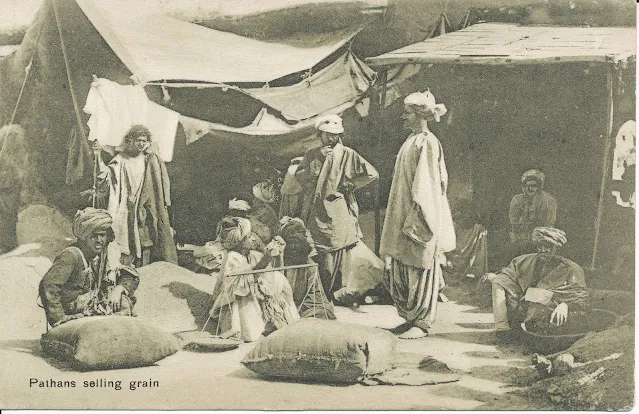The Achakzai is a sub-clan of Barakzai division of Durranis and the Barakzai Amirs and Kings of Afghanistan were their kinsmen. They are descendants of Achak Baba who is buried at Sra Karuna. Ahmad Shah Abdali, who feared the growing number of Barakzais, ousted Achakzais from Kandahar and surrounding area, and they separated from their parent stock. The clan left its parental home in Maruf and migrated eastward, and occupied the tract that is known as the Achakzai Toba. The Tarins then occupied this tract. However, the Nurzai, Alekozai and Achakzai gradually supplanted them. Presently they occupy Khwaja Amran Range in the Chaman sub-division, Inayatullah Karez, Chur Badezai, Khurgi and Anzari in the Pishin district.
Of the sections in Baluchistan, the Badea occupies Iskam Kaur, Arambi, Chinar and the Gwal Valley in Toba, the Ashezi part of the Sahora, Speslum and Tabina, the Hamidzai Tashrobat and adjoining valleys, the Nasratzai Farrakhi and Usmanzai occupy the country near the Ghwaza Pass.
The name Abdali is still used, though sparingly for the Achakzais, who became localized in Toba and are regarded a separate political unit from the rest of the Durranis. Some of the Achakzai families of Usmanzai clan are also found in Afghanistan as far as Uruzgan and Herat.
Killa Abdullah district is named after whom?
The district Killa Abdullah is named after a fort which was founded by Sardar Abdullah Khan Achakzai in early 19th century. The latter purchased Dehsora Karez from Kakars and Chasma Inzargai from Ashezai Achakzais and built a fort there and gave the place his own name. It was square shaped.
Abdullah Khan Achakzai's father Shadi Khan was an Arzbegi in the Durrani court (the arzbegi was responsible for dealing with claims against officials submitted by citizens). Around 1819, a quarrel took place between the two sons of Shadi Khan Arzbegi, in which Yar Muhammad Khan lost his life at the hands of Abdullah Khan, his younger brother. Quetta-Pishin Gazetteer (1907) records an anecdote about the manner of death which Abdullah Khan inflicted on Yar Muhammad Khan:
"In order to get rid of his elder brother, who stood between him and the inheritance, he caused him to be seized and buried him up to the chin in the earth. A rope was then fastened round his neck and to the end of it was haltered a wild horse: the animal was then driven round in a circle untill the unhappy victim's head was twisted from his shoulders."
During First Anglo-Afghan war, Haji Sarbuland Khan (son of Yar Muhammad Khan) and Saleh Muhammad Khan (Yar Muhammad Khan's nephew) espoused the cause of Saddozais and supported the British while Abdullah Khan, supported by the whole of the Achakzai tribe, took the Barakzai side and bitterly opposed the British advance in the area. He and his two sons were killed in the battle of the 23rd of September of 1841, in Kabul. Haji Sarbuland Khan was wounded fighting on the British side.
In 1907 Killa Abdullah was divided into three parts; the village; the railway station, the fort and serai; and the bazar. Its population in 1907 was 344 (males 182, females 162) and comprised 212 Achakzais, 40 Sayyids, 77 Kakars and 15 others. It possessed a mosque in charge of an Imam, who lived on zakat, and three rooms for students (talibs). The water supply to the village was from Dehsora karez the water being stored in a tank. The village possessed ten gardens, which covered an area of over 29 acres, the princapal fruits being grapes of the haita, sara kishmishi, and sahibi varieties, apricots, almonds and quinces. The Kandahari dealers bought the fruit and exported it to Quetta. It realized about Rs.2,000 per annum. Melons and watermelons were also grown.
Achakzai troopers, 1840 (c)
Achakzais launched fierce and frequent attacks on the baggage of Lord Keane’s army which in 1839. To keep open the communication through their country, a body of two hundred horsemen, was raised from among them and was stationed in the fort. A detachment of the 20th Bombay Infantry of British-Indian army was subsequently sent to strengthen the post, but circumstances necessitated the withdrawal of British from the fort. The Achakzais troopers deserted the British and cut down some of the British Infantry as they went off. In the plate, their Commander, Rissaldar Ghulam Khan, is represented on horseback, while two dismounted troopers occupy the foreground. Their uniform was a tunic of green cloth, and they were armed with matchlock, sword, and shield.
References:
1- "History of the Pathans" by Haroon Rashid, Vol-1
2- Hayat-i-Afghani
3- An account of the kingdom of Caubul, and its dependencies by Elphinstone
4- Quetta-Pishin Gazetteer (1907)
 |
| Fort of Killa Abdullah. Troopers of the Achakzai horse. 1847's painting by James Atkinson |
 |
| Sar Buland Achakzai(the seated one) , Photograph by Burke (1878-1880). |
 |
| Chaman Bazaar (Qilla Abdullah District, Balochistan Province). 1889's photo by Fred Bremner |
 |
| Chaman Bazaar (Qilla Abdullah District, Balochistan Province). 1889's photo by Fred Bremner printed on postcard. |
 |
| An Uchakzai Pashtun, Pishin valley, ca. 1889. Drawing from a photograph with notes on headwear. |
Very well written and I really appreciated your job. I wanted to ask can you write about the Alizai branch of Achakzai's, as there is not any well written articles on Alizai.
ReplyDelete